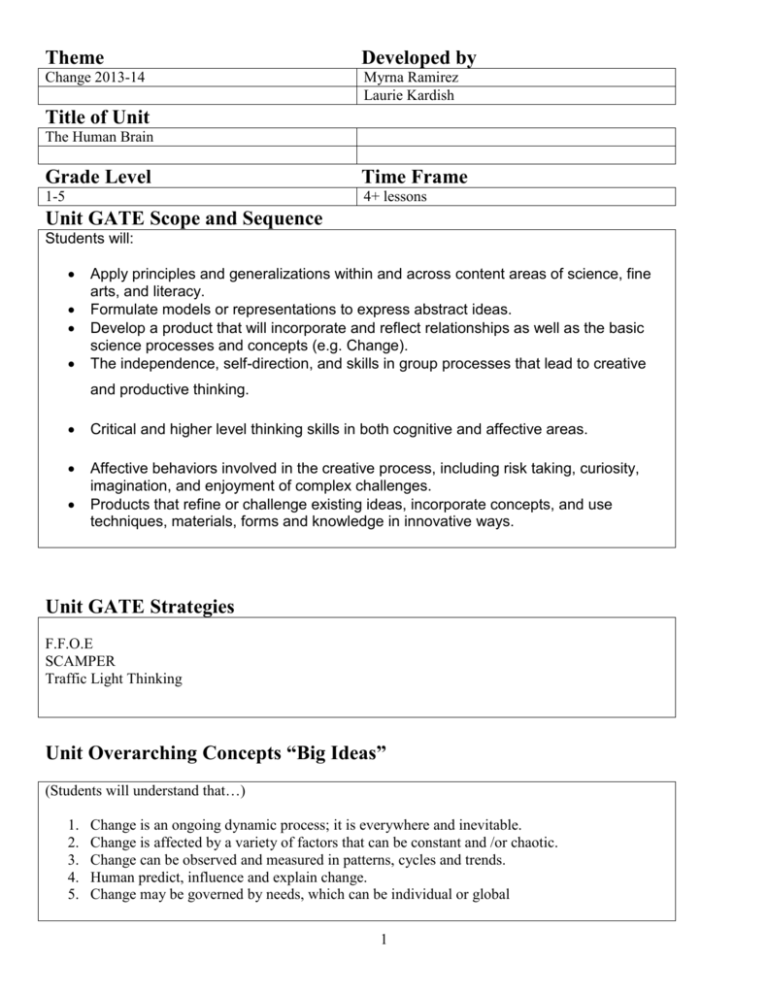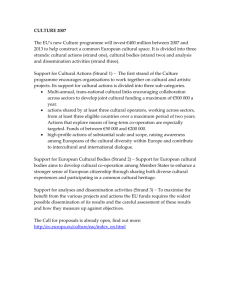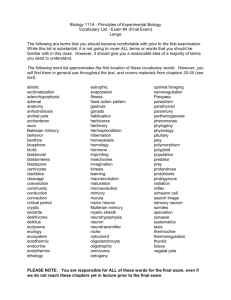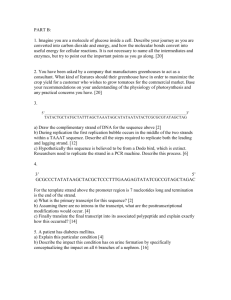Title of Unit
advertisement

Theme Developed by Change 2013-14 Myrna Ramirez Laurie Kardish Title of Unit The Human Brain Grade Level Time Frame 1-5 4+ lessons Unit GATE Scope and Sequence Students will: Apply principles and generalizations within and across content areas of science, fine arts, and literacy. Formulate models or representations to express abstract ideas. Develop a product that will incorporate and reflect relationships as well as the basic science processes and concepts (e.g. Change). The independence, self-direction, and skills in group processes that lead to creative and productive thinking. Critical and higher level thinking skills in both cognitive and affective areas. Affective behaviors involved in the creative process, including risk taking, curiosity, imagination, and enjoyment of complex challenges. Products that refine or challenge existing ideas, incorporate concepts, and use techniques, materials, forms and knowledge in innovative ways. Unit GATE Strategies F.F.O.E SCAMPER Traffic Light Thinking Unit Overarching Concepts “Big Ideas” (Students will understand that…) 1. 2. 3. 4. 5. Change is an ongoing dynamic process; it is everywhere and inevitable. Change is affected by a variety of factors that can be constant and /or chaotic. Change can be observed and measured in patterns, cycles and trends. Human predict, influence and explain change. Change may be governed by needs, which can be individual or global 1 Unit Lesson Objectives 1. After reading literature (Informational Text) -books, print outs, websites, etc, - on the human brain, students will correctly demonstrate the knowledge of the parts of the human brain, their basic functions using a Thinking Maps “Tree Map”. 2. Given pictures and information of the human brain students will creatively make a model of the human brain 3. Given pictures of the human brain, students will correctly create a model of the Triune Brain, demonstrating their understanding of the different parts of the inner brain. 4. Given examples, students will correctly write word analogies and metaphors related to the human brain. 5. After listening to a song about the human brain in a familiar tune, students will write and perform a song of their own. 6. Given information of how neurons work in the brain, students will create a drawing, a model and play a game to learn and demonstrate their understanding of how neurons work in the brain. Unit Related Misconceptions The human brain is easy to understand. Everybody’s brain is the same. The brain is like a control center. ASSESSMENT EVIDENCE Unit Summative Performance Task Description Students will choose one idea from the menu extension to explore in detail at home. Students will present their project to the class. 2 Unit Materials/Resources The Big Book of the Brain by John Farndon In GATE resource room: The Brain: our nervous system by Seymour Simon Your 21st Century Brain Amazing Science Games to Play With your Mind by DiSpezio & DeSalle How to be a GENIUS your brain and how to train it by Woodward Websites: Lumosity: Brain Games & Brain Training www.lumosity.com/ http://faculty.washington.edu/chudler/introb.html Theme Unit Change The Human Brain Discussion Questions How many parts make up the human brain? What functions do these parts perform for the human body? Name The Human Brain Parts and Their Basic Functions Resources Date 2013-14 Books about the human brain. Handouts provided by teacher Internet websites 3 EXTENSIONS MENU Make a Giant Jigsaw Puzzle showing a picture/s and facts about the brain. Challenge students in class to complete it. Make several different, unique models of neurons and demonstrate how they function in the brain. Create a Cross- Word Make a unique model of the human brain label puzzle using facts the parts and describe their functions. Present in about the brain. class. AND/OR List True/False statements about the brain. Challenge: Using a shoebox, create a game with wires/light bulb/battery to test knowledge of T or F statements. Student Choice (Talk with teacher about your idea for approval) Design a board game about the Human Brain. Must be complete with instructions to be able to play in class. Design a Power Visit internet site: Point presentation on Write and perform the human brain. your own song about http://faculty.washington.edu/chudler/introb.html the brain using musical instrument/s. Chose an area or areas of interest and present your new knowledge in an interesting manner to the class. Use visuals. 4 Lesson Design Model – Parts and their basic functions ANTICIPATORY SET Teacher puts closed fists together and asks students what they think it may be a model of. Ask students: “How many parts do you think the human brain has?” OBJECTIVE (EEI FOUR PART) After reading books and hand-outs on the human brain students will correctly identify/label the parts of the brain and their functions by creating a paper model. LEARNING SUB-OBJECTIVE Strand 4: Life Science Concept 1: Structure and Function in Living Systems Understand the relationships between structures and functions of organisms. PO 3. Identify the functions and parts of the nervous system: control center – brain PO 1. Identify how diverse people and/or cultures, past and present, have made important contributions to scientific innovations (e.g., Percy Lavon Julian [scientist], supports Strand 4; Niels Bohr [scientist], supports Strand 5; Edwin Hubble [scientist], supports Strand 6).(1-S2)p TEACHER ACTIONS-STRATEGIES STUDENT BEHAVIORS ACTIVE PARTICIPATION 1. Teacher models the human brain by placing closed fists together and elicits student guesses as to what it may be a model for. 2. Ask students for their prior knowledge of the human brain including names of parts and their functions (intro Fluency) 3. Introduce basic physiology of the brain using handouts and “A Tour of the Human Brain-Part One”. Teacher brings a single sheet of newspaper, a 3-lb bag of beans or rice, large grapefruit and walnut for demonstration. 1. Students brainstorm ideas (Fluency-Originality) 4. 4. Students complete worksheets provided and a “Tree Map” (graphic organizer) showing their knowledge of the parts of the brain.. Provide additional hand outs and books on the human brain for students to read in pairs. 2. Work with a partner on a butcher paper to show their prior knowledge. 3. Students listen to the reading. Teacher will place a 3lb bag of beans or rice in their palms to show the average weight of an adult brain. Students will spread open a newspaper sheet to see the size of the cerebral cortex if it could be spread out, a large grapefruit is the avg size of a brain and a walnut shows the shape with the wrinkles. 5 5. Explain what metaphors are, and share a few brain metaphors (see maser file). (Introduce SCAMPER and/or FFOE to use as students create their own metaphors.) Ask students what the metaphor would look like as a picture. 6. Introduce Traffic Light Thinking. The beginning of the metaphor is a Red light statement because it is true for the author. Then students can read and use Yellow light thinking to infer the author’s reasoning. Green light thinking is used to complete the metaphor. 5. Students write their own metaphors about the brain and draw pictures to demonstrate their metaphors. 6. Students write the first part of the metaphor on one paper, then the ending on another Classmates complete the analogy for themselves. 7. Students creatively make a model of the human brain using materials provided by teacher. 7. Provide students construction paper, markers, crayons, glue. 8. 8. Teacher sings a song about the brain (see Master file) using a familiar tune like “Twinkle, Twinkle Little Star”. Students are asked to write and perform their own song. Students listen to teacher’s song then write and perform their own song in groups. Teacher may challenge them to include percussion. MODELING Teacher begins to model filling out the “Tree Map” about the human brain. Teacher explains what metaphors are and reads a few about the brain. Teacher sings a song about the brain in a familiar tune (Twinkle, Twinkle Little Star) GUIDED PRACTICE Students work with a partner to filling out the graphic organizer: “Tree Map”. Students write their own metaphors about the brain. Students work in groups to write and perform a song about the human brain. Students and teacher work together to come up with a brief summary naming the parts and functions of the human brain to for students to write in their journals. 6 INDEPENDENT PRACTICE Students fill out the Tree Map recording parts and functions of the human brain. Students complete given handouts about the human brain. Students write a brief summary, using facts to make inferences about the human brain. Students write metaphors and create drawings about the brain. Students write and perform a song about the brain. CLOSURE In small groups students will share and write in their journals all they know now about the parts and the functions of the human brain. Students will post their metaphors about the brain. 7 Lesson Design Model- Neurons ! ANTICIPATORY SET We’ve been studying about the brain and it’s parts/ functions. Could anyone explain how does one thought/sensation get communicated in the brain? We know there is a change from sensation to communication in the brain. When my finger touches this needle, how does my brain tell me to remove it? How could we make an analogy with the way people communicate? OBJECTIVE (EEI FOUR PART) After learning how information/sensations are communicated in the brain, students will create a drawing, be able to create a model of a neuron and participate in a game correctly demonstrating how neurons make connections in our brain. LEARNING SUB-OBJECTIVE Strand 4: Life Science Concept 1: Structure and Function in Living Systems Understand the relationships between structures and functions of organisms. PO 3. Identify the functions and parts of the nervous system: control center – brain PO 1. Identify how diverse people and/or cultures, past and present, have made important contributions to scientific innovations (e.g., Percy Lavon Julian [scientist], supports Strand 4; Niels Bohr [scientist], supports Strand 5; Edwin Hubble [scientist], supports Strand 6).(1-S2)p TEACHER ACTIONS-STRATEGIES STUDENT BEHAVIORS ACTIVE PARTICIPATION 1. Teacher shares neuron information. Then direct students to do the Nerve Cell –Dot Activity.Directions: Get a piece of paper and 10 different colored crayons. Make 10 dots on the paper, using a different colored crayon for each dot.(These dots represent nerve cells of the brain.) With the red crayon, draw lines from the red dot to each of the other dots. (These lines represent the dendrites of each nerve cell.) With each of the other crayons draw lines from its dot to all the other dots. (When you are finished there should be nine lines starting from each dot.) This project is easy, but imagine that a person has more than fifteen billion nerve cells in a human brain. 1 Students create a drawing of nerve cells 8 2. Teacher shows hand-out of neuron. Guides students to make a pipe-cleaner model of neuron. Take 5 colors, one each for the Nucleus, Dendrites, Axon, Myelin sheath, Synaptic terminal 2. Students create a model of a neuron. 3. We can enact the different parts of the Neuron by playing a “Neuron Game”. This will help students to understand how the neuron, dendrites, and synapse create connections. Directions: One student will come up with a topic/subject (ex: sports, geography, science etc.) The next student, and each student there after will join a hand and continue the chain by adding more information about the topic. After students have had a turn the last student can begin a new chain with a new topic. 3. Students play game. MODELING Teacher shares neuron information and models a way to draw the cells and how they communicate information. Next the model of a neuron is shown and how to make the parts that create the connections. Finally how to play the Neuron Game is demonstrated. GUIDED PRACTICE Students create a drawing, a model and play the neuron game. INDEPENDENT PRACTICE Students write in journals to show their learning of nerve cells explaining how this lesson demonstrates change. CLOSURE Students discuss, write and share answering the following questions. What is physically happening in our brain when we are learning something new? How are the neurons responsible for learning something new? 9 Lesson Design Model – Triune Brain ANTICIPATORY SET Did you know there are different ways researchers have looked at the brain? We have learned about the external parts of the brain: the cerebellum, the cerebrum and the brain stem. Now let’s look at the way a neuroscientist talks about the three brains that we have! Neuroscientist - a scientist that studies the molecular and cellular levels of the nervous system, and of systems within the brain such as vision and hearing, and of behavior produced by the brain. OBJECTIVE (EEI FOUR PART) Given information about the Triune Brain, students will successfully create a torn paper model with the parts and functions correctly labeled. LEARNING SUB-OBJECTIVE Strand 4: Life Science Concept 1: Structure and Function in Living Systems Understand the relationships between structures and functions of organisms. PO 3. Identify the functions and parts of the nervous system: control center – brain PO 1. Identify how diverse people and/or cultures, past and present, have made important contributions to scientific innovations (e.g., Percy Lavon Julian [scientist], supports Strand 4; Niels Bohr [scientist], supports Strand 5; Edwin Hubble [scientist], supports Strand 6).(1-S2)p TEACHER ACTIONS-STRATEGIES STUDENT BEHAVIORS ACTIVE PARTICIPATION 1. Teacher introduces and passes out the Triune Brain Model handout. Guides students to find key information that will be used to create a model. 2. Teacher passes out 3 different colored papers. Using their hands, students tear out the three parts of the triune brain from the colored paper to glue to the outlined pattern of a human brain. Then write the major functions of each part and glue it on. 1. Students work in pairs and underline key information needed to be able to create a model of the Triune Brain labeled with the functions of each part. 2.Students create a model of the Triune Brain labeled with the functions each part performs. MODELING Teacher begins to model how to find the key words defining the functions of the parts of the Triune Brain, and how to tear the paper and create a model of the Triune Brain. 10 GUIDED PRACTICE Students work with a partner to underline key words. Students and teacher work together to begin the Triune Brain Model. INDEPENDENT PRACTICE Students create their own model of the Triune Brain with the parts and functions correctly labeled. CLOSURE In small groups students will share and write in their journals the impact of learning of the Triune Brain. What did it contribute to our learning about the brain? 11








